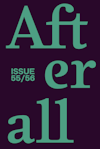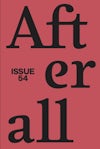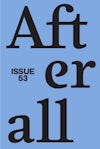
Issue 31
Autumn/Winter 2012
Afterall issue 31 looks at migration and transformations in identity, with essays on Lukas Duwenhögger, Boudry/ Lorenz, Ivan Kožari?, Sven Augustijnen, Almagul Menlibayeva and Slavs & Tatars. Accompanying texts address the cancelled exhibition ‘Fighting City’ and Paul Chan’s war trilogy.
Editors: Nuria Enguita Mayo, Melissa Gronlund, Anders Kreuger, Pablo Lafuente, Stephanie Smith, Helena Vilalta.
Founding editors: Charles Esche, Mark Lewis.
Table of contents
Foreword
Contextual Essays
- Crisis, Migration and the Death Drive of Capitalism – Dimitris Papaopoulos & Vassilis S. Tsianos
Artists
Almagul Menlibayeva
- Almagul Menlibayeva: Wanderings and Incarnations – Yuliya Sorokina
- Almagul Menlibayeva: The Female as Excess – Viktor Misiano
Ivan Kožari?
- Ivan Kožari?: ‘Freedom Is a Rare Bird’ – Branka Stipan?i?
- Ivan Kožari?: A Feeling of Wholeness – Ana Devi?
Boudry/Lorenz
- Repetition and Change: The Film Installations of Pauline Boudry and Renate Lorenz – Gregg Bordowitz
Lukas Duwenhögger
- Lukas Duwenhögger: [Homosexual] Signs – Roger Cook
Sven Augustijnen
- Documentary as Anti-Monument: On Spectres by Sven Augustijnen – Robrecht Vanderbeeken
- Neither Fish nor Fowl, but Real Bodies: The Films of Sven Augustijnen – Sophie Berrebi
Slavs and Tatars
- Beyond Nonsense: What Slavs and Tatars Make – Anders Kreuger
Events, Works, Exhibitions
- The Pull of Violence: Paul Chan’s Trilogy of War – Paolo Magagnoli
- Information Crossings: On the Case of Inconnu’s ‘The Fighting City’ – Juliane Debeusscher
Foreword
Written by Helena Vilalta
Looking in an unlikely place for signs of a world in transformation, William E. Jones’s video essay The Fall of Communism As Seen in Gay Pornography (1998) compiles footage from gay porn films produced between 1993 and 1998 in the former Eastern bloc and distributed in the United States. Watching this film recently I was struck by how disturbing Jones’s montage remains today. Under twenty minutes long, the footage is arranged into two chapters, each constructed around a visual motif. The first assembles brief close-up portraits in which young men look straight at the camera, some with pleasure, but most with insecurity, disgust or blatant indifference to the sexual exchanges taking place off-screen. The staging of the scenes in modest domestic interiors, alongside the artist’s commentary, underlines the actors’ inexperience and points at the conditions of exploitation surrounding these productions, which were made at a time when the porn industry sought to reap economic profit from the collapse of the Soviet Union. Presented as auditions, but distributed for consumption, longer sequences in the second part of the film show interviews conducted by a British male, whose face and body remain largely off-screen. He asks young men intimate questions about their sex lives and reasons for appearing in these films, at times stroking them as they pose for the camera — the contrast of his gold watch and fine blue shirt against their cheap clothes, or bare skin, standing as a sign of capitalism’s victory over communism. Their short replies leave us with no doubt: they are loaning their bodies to the camera in exchange for Western money ($50 per session, according to the artist).
In the simple gesture of a glance back at the camera, Jones captures the vulnerability of a generation that came of age in a moment of political uncertainty. Two decades later, and at another geo-political turning point — when the United States and Europe’s hegemonic position within global financial capitalism is in crisis — those glances are a poignant reminder of the human experience that lies behind the economic statistics on newspaper front pages. Likewise, this issue of Afterall attempts to shift our attention away from the intangible drama of fluctuating and ever-faster flows of abstract capital, and towards the question of how the mobility of people, information and affects shapes subjectivities, our bodies and our desires. Concerned with an embodied politics of mobility, the essays brought together here ask whether an aesthetic and political imaginary based on change still holds a subversive potential today. Can mobility encapsulate a critique of the way identity is policed, or has its meaning been reduced to a state of permanent adaptability to the needs of the market?
In the opening essay, Vassilis S. Tsianos and Dimitris Papadopoulos counter the common understanding of migration as a merely reactive force, considering instead the creative agency of migration and its ability to stir political change. Charting the role that migrant labour has played in the consolidation of neoliberal capitalism over the past fifty years, the authors propose that today’s trans-migration constitutes the death drive of capitalism — as well as the death drive of the left liberal and revolutionary thinking, since it ultimately undermines any political imagination based on national citizenship. Conceiving of migration as an autonomous social force, they call for a redefinition of political subjectivities as the working classes become both transnational and precarious.
Such a shift in perspective — one that understands migrant subjectivities not in relation to a static definition of political identity but as a process of becoming — is not only relevant for a representation of transnational mobility, but also of queer subjectivities. As Roger Cook, quoting Eve Kosofsky Sedgwick, reminds us in this issue, ‘queer is a continuing moment, movement, motive — recurrent, eddying, troublant’. 1 The crossing of positions characteristic of queer subjectivities is manifest in Pauline Boudry and Renate Lorenz’s film installations, which portray ways of being that defy normative definitions of identity and celebrate self-determination instead. In their films, queer performers re-stage historical portraits of characters that have resisted the constraints of capitalism, patriarchy or colonialism, and whose ‘otherness’ has often signified marginalisation, if not persecution. Lukas Duwenhögger’s theatrical paintings and installations also draw from the history of homosexual social and cultural codes, and their use of irony, to visualise an identity built on difference. Tracing a parallel between Jacques Rancière’s theory of disagreement and queer theories of difference, Cook suggests that Duwenhögger’s incarnation of a specifically queer experience of dissent in an aesthetic form transcends any categorisation as ‘homosexual’.
Purchase
The publication is available for purchase. If you would like specific articles only, it is also available individually and to be downloaded as PDFs.
Purchase full publication
Buy via University of Chicago Press
Buy via Central Books
Purchase individual articles
Buy via University of Chicago Press



